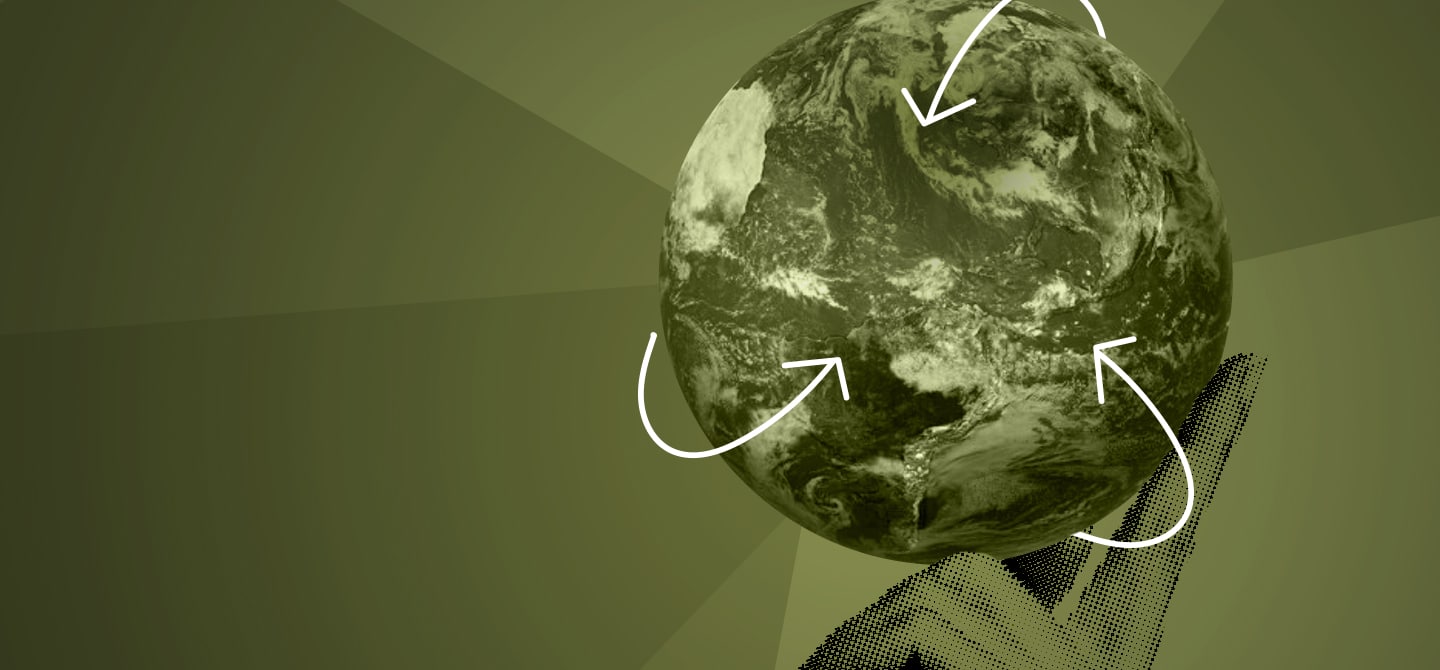Much of the materials, water, or energy that we produce today is either lost, wasted, or discarded from the economic system even though they still have value. A circular economy model questions how that value can be retained or even created from resources – that would, under other circumstances, be lost or wasted – through reduction, reusing, repairing, remanufacturing, recycling and recovering of these resources. Hence, a circular economy is an opportunity to rebrand unwanted waste and losses into valuable resources.
#1 Circular economy is a recycled notion
Let’s re-establish the truth around a common misconception: circular economy is not a novel revolutionary idea. As far back as 1966, the economist Kenneth Boulding defined what we can qualify as the embryonic notion of circular economy. In his essay, “The Economics of the Coming Spaceship Earth,” he describes an economy of the past as one with seemingly unlimited resources, reckless and exploitative behaviour of extraction, production, and consumption. He compares it to a closed economy of the future, which he calls: the “spaceman” economy.
In a spaceman economy, “the Earth has become a single spaceship, without unlimited reservoirs of anything, either for extraction or for pollution, and in which, therefore, man must find his place in a cyclical ecological system which is capable of continuous reproduction of material form even though it cannot escape having inputs of energy.” Also, in 1990 the term circular economy was explicitly coined in an environmental economics book1 and in the Chinese law promoting circular economy2.

#2 Circular economy is now a well branded discourse
The Ellen MacArthur Foundation (EMF) and the consulting firm McKinsey joined forces to strengthen the argument for the solution proposed by the circular economy to the problems created by the linear economy. They staggeringly succeeded in embarking a wide panel of economic actors and policymakers through a well branded and attractive discourse, clear visual representations of circular biological and technical fluxes, canvas, and concrete models.
As such, circular economy was then perceived as a way out of the economic crisis of 2010. Back then, the economic sphere suffered from the soaring prices of raw materials due to the high demand inflicted by the Chinese economic development, the global embargo by China on rare metals, and the global environmental degradation and damages translated by concrete indicators and proofs3. Other institutions followed the lead of the EMF and started introducing their own perceptions and definitions for circular economy4, such as the French Agency for Ecological Transition (ADEME). To date, there are more than 100 definitions carrying different meanings5!
#3 Circular economy is an impossible physical utopia
A circular economy where waste no longer exists, and all resources are indefinitely valued is unrealistic. In any pragmatic system, it is impossible to have perfectly closed resource loops containing indefinitely recycled or recyclable materials and entirely recovered dissipated energy due to thermodynamics constraints6.
A circular economy is an opportunity to rebrand unwanted waste and losses into valuable resources.
In fact, there are limitations in material properties leading to unavoidable wear and tear7. For example, due to material fatigue after use, the recycling of aluminium is limited to a number of cycles, and to ensure it meets quality standards, the addition of approximately 5 % pure virgin aluminium is required8. Also, multiple plastic recycling cycles reduce the polymer chains they contain, which degrades quality9. There are also limitations in technologies leading to inevitable dissipation in the environment, possible contamination, and retaining of hazardous substances in the economy when engaging in circular economy activities. Illustrative examples of this issue are sludges from industrial waste waters, that contain nutrients like phosphorus, and incineration bottom ashes containing scrap metals. They can respectively be used as fertilizers and construction aggregates whilst avoiding the extraction of virgin materials such as mineral fertilizers and gravels. However, their level of pollutants is higher than the traditional material they replace10. These factors make it hard for companies to replace well-functioning value chains with primary resources with waste as a resource from circular activity.
Concerning energy, it is in constant need across the world. And, while we can capture, transform, and transport it, each of these operations in turn consumes energy with the available technologies we have11. Hence, having closed energy loops without additional inputs of energy is consequently unfeasible in the foreseeable future.
#4 Circular economy cycles are not always green
Numerous benefits can be associated with circular economy principles – namely, a reduction in the extraction of primary resources and waste creation. However, for many researchers, there is still significant uncertainty on the concrete positive environmental and social impact of circular economy. Some argue that implementing circular strategies does not by default diminish environmental impact12 for a simple reason: The Rebound Effect (Jevon’s Paradox). It happens “when circular activities, which have lower per-unit-production impacts, also cause increased levels of production, reducing their benefits.”13
The ‘Circular Rebound Effect’ happens when circular activities, which have lower per-unit-production impacts, also cause increased levels of production, reducing their benefits.
Different mechanisms can lead to a circular rebound effect14. For example, when secondary products (from upcycling, reusing, remanufacturing, or recycling activities) are not adequate substitutes to primary products (products manufactured using virgin materials). A recent study showed that a company selling upcycled marble slabs generated an additional environmental impact equal to 13.2% of the emission savings expected15. The secondary product being inadequate for the market, it was not able to draw customers away from the primary product. Another mechanism triggering rebound effect is clients’ behaviour such as increased consumption or use. In the United States, researchers showed that smartphone reuse generated a rebound effect that offsets from 30 to 45 % of the expected emissions savings16. As such, avoiding these rebound effects requires ecosystemic thinking to keep an eye on the full picture.
Furthermore, concerns are being raised about the social costs of a circular economy. Bad working conditions, power asymmetries, issues of equity and inclusion may be overlooked17. Examples of this involve jobs in collecting and sorting recycling content, and repairing activities undertaken by socially marginalized groups. Studies estimated that in 2016 approximately 58% of all plastic recycled globally was collected by the informal sector1819, often operating in unsafe conditions and without employment benefits2021. This leads to weak circularity22 excluding social responsibility and reinforcing unequal power relations.
Therefore, professionals are developing indicators and metrics allowing managing the deployment of circular practices and assessing their actual impact232425. The objective is to make it less easy to make unfounded statements on the circular economy and bring real issues raised by the transition.
#5 Circular economy is a matter of creative collaboration
The metaphor of the circle is a powerful tool. It helps companies rethink the way they produce and the way we consume. It triggers creative thinking and fosters cooperation between economic actors to create bright solutions. It can be done through new partnerships, management indicators, methods of eco-design, frugal conception of materials and energy use, criteria for performance evaluation and value creation26.
Ultimately, the issue raised is how to stimulate cooperation not only within companies and entire industries, but also with governments and policymakers to make it happen. It is time for producers and the state to reclaim the idea of strong circularity based on “a closed, material loop limited in size and space, embedding the principle of fair distribution of resources”27. It is time to push aside false hopes and promises of the utopian circular economy and provide careful explanations of its limits and cocreating auspicious conditions to implement it successfully.








